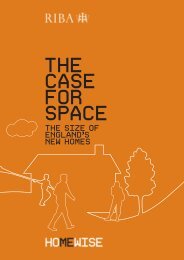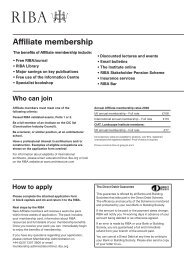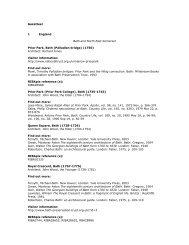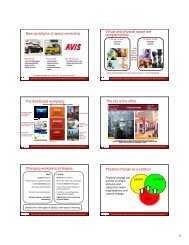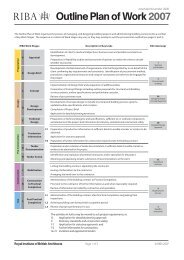Albertopolis Walking Tour: transcript - Royal Institute of British ...
Albertopolis Walking Tour: transcript - Royal Institute of British ...
Albertopolis Walking Tour: transcript - Royal Institute of British ...
You also want an ePaper? Increase the reach of your titles
YUMPU automatically turns print PDFs into web optimized ePapers that Google loves.
3. Science Museum<br />
4.00mins<br />
The Science Museum is the youngest <strong>of</strong> the<br />
museums in the Exhibition Road Cultural<br />
Quarter, although its origins date back to the<br />
Great Exhibition <strong>of</strong> 1851. The study <strong>of</strong> science<br />
was a key part <strong>of</strong> the exhibition’s objective, and<br />
this ideal was continued by Prince Albert and<br />
the 1851 Commissioners when they developed<br />
the area <strong>of</strong> South Kensington.<br />
Although the first museum, the South<br />
Kensington Museum which opened in 1857, is<br />
though <strong>of</strong> as an arts institution, science<br />
collections featured in its very first building, the<br />
Brompton Boilers. As the science collections<br />
expanded during the 1860s they had to be<br />
gradually moved across Exhibition Road, in to<br />
storage in buildings originally constructed for<br />
the International Exhibition <strong>of</strong> 1862.<br />
The East Block <strong>of</strong> the Science<br />
Museum, 1928<br />
Copyright: Science Museum/SSPL<br />
From 1893 the science collections had their own director but they were still administered as<br />
part <strong>of</strong> the South Kensington Museum. The science accommodation was by now inadequate<br />
and the scientific community argued for new and appropriate buildings.<br />
The committee planned a range <strong>of</strong> buildings all the way from Exhibition Road to Queen’s<br />
Gate. In reality only a small proportion <strong>of</strong> the proposed buildings were ever built.<br />
Construction work began on the East Block in 1913, and this is the building which you see<br />
before you today.<br />
Due to World War I the museum was not fully opened until 1928. It was designed by the<br />
Office <strong>of</strong> Works and the architect Sir Richard Allison (1869-1958). Allison, who was a<br />
Scotsman, used the department store as a model for the inside <strong>of</strong> the museum and the<br />
Edwardian <strong>of</strong>fice building for the outside. Having said that, the Science Museum’s exterior<br />
does also bear some resemblance to Selfridges on Oxford Street.<br />
Allison designed generous circulation spaces inside the museum, and a ro<strong>of</strong> lit central hall<br />
which serves very well for the display <strong>of</strong> large engines. He also created open galleries at the<br />
sides, lit naturally as was the fashion at the time.<br />
In 1996 some westward expansion at South Kensington finally began. The Wellcome Trust<br />
sponsored a new building which was to become the Wellcome Wing <strong>of</strong> the museum. This<br />
was opened by HM The Queen in June 2000 and houses exhibitions <strong>of</strong> present and future<br />
science and technology.<br />
If you cross over Exhibition Road to stand at the entrance to the Science Museum you’ll see<br />
on the opposite side <strong>of</strong> the road a striking modern church that is the Church <strong>of</strong> Jesus Christ<br />
<strong>of</strong> Latter-Day Saints. This Mormon church was designed by T.P Bennett and Son in 1961.<br />
Also worth noting is the large block <strong>of</strong> flats immediately next door to the church, numbers<br />
59-63 Prince Gate. This is a 1930s interpretation <strong>of</strong> the white stuccoed terraces <strong>of</strong> South<br />
4




